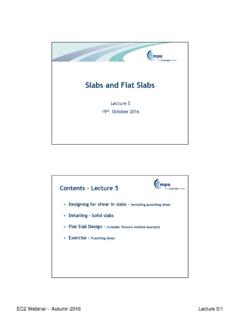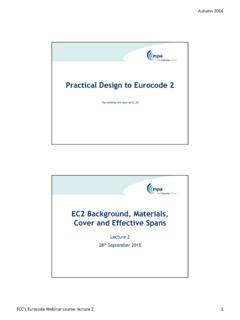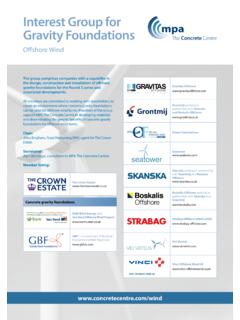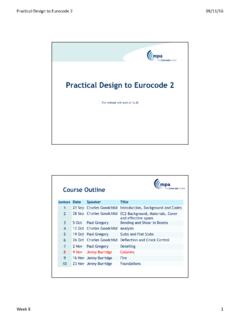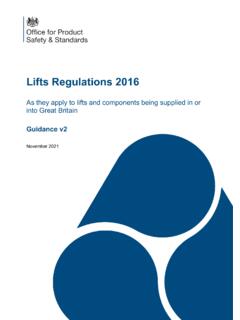Transcription of Practical Design to Eurocode 2 - concretecentre.com
1 autumn 2016 . Practical Design to Eurocode 2. The webinar will start at Crack Control and Deflection Lecture 6. 28th October 2015. TCC's EC2 webinar lecture 6 1. autumn 2016 . Model Answers Lecture 5 Exercise: Check an edge column for punching shear Punching shear at column C1. 400 mm Square Column 300 mm flat slab C30/37 concrete Design information At C1 the ultimate column reaction is kN. Effective depths are 260mm & 240mm Reinforcement: ly = , lz = TCC's EC2 webinar lecture 6 2. autumn 2016 . Punching shear exercise For the previous flat slab example: C1. a) Check the shear stress at the perimeter of column C1. The u0 perimeter. b) Check the shear stress at the basic perimeter, u1. c) Determine the distance 9600. of the uout perimeter from the face of column C1. d) Determine the area of shear reinforcement required on a perimeter.
2 Find Asw for the u1. perimeter. Solution C. a) Check shear at the perimeter of the column = 1,5. vEd = VEd/(u0d) < vRd,max = d = (260 + 240)/2 = 250 mm B A. = 1,4. u0 = c2 + 3d < c2 + 2c1 For edge columns = 1,15. u0 = 400 + 3 x 250 < 400 + 2 x 400. u0 = 1150 mm vEd = x x 1000/(1150 x 250). = MPa c2. vRd,max = fcd = x (1-fck/250) x cc fck/ m c1. = x (1-30/250) x x 30 = MPa vEd < vRd,max ..OK. TCC's EC2 webinar lecture 6 3. autumn 2016 . We can calculate if we wish. See (4). Solution Rab's questions But that involves moments, u1*, W1, epar etc. = is easy if conservative. C. a) Check shear at the perimeter of the column = 1,5. vEd = VEd/(u0d) < vRd,max = d = (260 + 240)/2 = 250 mm B A. = 1,4. u0 = c2 + 3d < c2 + 2c1 For edge columns = 1,15. u0 = 400 + 3 x 250 < 400 + 2 x 400. u0 = 1150 mm vEd = x x 1000/(1150 x 250).
3 = MPa c2. vRd,max = fcd = x (1-fck/250) x cc fck/ m c1. = x (1-30/250) x x 30 = MPa vEd < vRd,max ..OK. See Exp ( ). Solution b) Check shear at u1, the basic control perimeter vEd = VEd/(u1d) < vRd,c c2. , VEd as before c1. u1 = c2 + 2c1 + x 2d u1. = 400 + 2 x 400 + x 2 x 250 = 2771 mm vEd = x x 1000/(2771 x 250) = MPa vRd,c = k(100 l fck)1/3 from flexural k = 1 + (200/d)1/2 = 1 + (200/250)1/2 = calcs l = ( ly lx)1/2 = ( x ) 1/2 = vRd,c = x (100 x x 30)1/3 = MPa vEd > vRd,c ? MPa > MPa .. Therefore punching shear reinf. required NA check: vEd ,c at basic control perimeter MPa 2 x MPa = MPa - OK. TCC's EC2 webinar lecture 6 4. autumn 2016 . Solution c) Perimeter at which punching shear no longer required uout = VEd/(dvRd,c). = x x 1000/(250 x ). = 5333 mm Rearrange: uout = c2 + 2c1 + rout rout = (uout (c2 + 2c1))/.
4 = (5333 1200)/ = 1315 mm Position of outer perimeter of reinforcement from column face: r = 1315 x 250 = 940 mm Maximum radial spacing of reinforcement: sr,max = x 250 = 187 mm, say 175 mm Solution d) Area of reinforcement Asw (vEd ,c)sru1/( ,ef). fywd,ef = (250 + ) = 312 MPa Asw ( x ) x 175 x 2771/( x 312). 777 mm2 per perimeter Within the u1 perimeter the link spacing around a perimeter, st = x 250 = 375mm Outside the u1 perimeter the link spacing around a perimeter, st 2d = 500 mm Use say st,max = 350 mm Minimum area of a link leg: Asw,min ( sr st (fck)) /fyk = x 175 x 350 x 30 / 500. 36 mm2. Use either H8s (50 mm2) and this would need 16 per perimeter or H10s ( mm2) and 10 per perimeter. @ 350 mm tangential spacing and @175 mm radial spacing TCC's EC2 webinar lecture 6 5. autumn 2016 . Crack Control and Deflection Lecture 6.
5 28th October 2015. Outline Lecture 6. General Crack control Deflection Worked Example Design Exercise TCC's EC2 webinar lecture 6 6. autumn 2016 . General 15. What does Eurocode 2 Cover? Cl. Concise General ( ). (1) Generally SLS limit states are: stress limitation (see ), control of cracking (see ), and control of deflections (see ). Vibration may be important but is not covered. TCC's EC2 webinar lecture 6 7. autumn 2016 . What does Eurocode 2 Cover? Cl. Concise (2) In the calculation of stresses and deflections, cross-sections should be assumed to be uncracked provided that the flexural tensile stress does not exceed fct,eff. The value of fct,eff may be taken as fctm or fctm,fl provided that the calculation for minimum tension reinforcement is also based on the same value. For the purposes of calculating crack widths and tension stiffening fctm should be used.
6 [From Table , fctm = (2/3) for C50/60]. What does Eurocode 2 Cover? Stress limitation Unacceptable cracking may be assumed to be avoided if ck < and sk < BUT:- PD 6687 Cl. : Stress checks in reinforced concrete members have not been required in the UK for the past 50. years or so and there has been no known adverse effect. Provided that the Design has been carried out properly for ultimate limit state there will be no significant effect at serviceability in respect of longitudinal cracking . Control of cracking Control of deflections ( ). TCC's EC2 webinar lecture 6 8. autumn 2016 . Crack control 19. Control of Cracking Cl. In Eurocode 2 cracking is controlled in the following ways: Minimum areas of reinforcement Cl & Exp ( ). Limiting crack widths. wkmax is determined from Table (in the UK from Table ). These limits can be met by either: deemed to satisfy' rules (Cl.)
7 Direct calculation (Cl. ) Design crack width is wk Note: slabs 200mm depth are OK if As,min is provided. TCC's EC2 webinar lecture 6 9. autumn 2016 . Control of Cracking Cl. Minimum areas of reinforcement As,min s = kckfct,effAct Exp ( ). where s = Stress in the reinforcement ( = fyk) Essentially: force in un-yeilded kc = Stress distribution factor: reinforcement tensile force in concrete just before it = for pure tension cracks. = (1- c /(k1(h/h*)fct,eff). where: c = NEd/bh Exp ( ) is the same as k1 = for compression Asmin used in Asmin for beams in = */h for tension (1). See later Detailing. h* = Max(h, 1000 mm). fct,eff = fctm = (2/3) for C50/60 (or lower if cracking is expected before 28 days). k = Coefficient to allow for non-uniform equilibrating stresses'. = for h = 300 mm = for h = 800 mm. Interpolate between.)
8 Act = area of concrete within tensile zone. The tensile zone is that part of the section which is calculated to be in tension just before formation of the first crack Control of Cracking Table but - use Table Crack Width Limits Recommended values of wmax Exposure class RC or unbonded PSC Prestressed members members with bonded tendons Quasi-permanent load Frequent load X0,XC1 * XC2,XC3,XC4 XD1,XD2,XS1, Decompression XS2,XS3. * Does not affect durability, may be relaxed where appearance is not critical (eg use mm). TCC's EC2 webinar lecture 6 10. autumn 2016 . Crack Control Without Direct Calculation Cl Crack control (due to flexure) may be achieved in two ways: limiting the maximum bar diameter using Table limiting the maximum bar spacing using Table NB: Where cracking is due to restraint use only limiting max.
9 Bar size Maximum Bar Diameters Cl. Table Crack Control 50. wk = maximum bar diameter (mm). 40. 30. wk= mm 20 wk= mm 10. 0. 100 150 200 250 300 350 400 450 500. Reinforcement stress, s (N/mm2). (Stress due to quasi-permanent actions). TCC's EC2 webinar lecture 6 11. autumn 2016 . Maximum Bar Spacings Cl. Table Crack Control 300. wk = Maximum bar spacing (mm). 250. 200 wk = 150. 100. wk = 50. 0. 150 200 250 300 350 400. stress in reinforcement (MPa). (Stress due to quasi-permanent actions). Calculation of crack widths Cl Crack width, wk = sr,max cr Exp ( ). where sr,max = Maximum crack spacing = + (k1k2 / p,eff) Exp ( ). where c = nominal cover, cnom k1 = k2 = for tension ( from restraint). = for bending = ( 1 + 2)/2 1 for combinations of bending and tension = diameter of the bar in mm. p,eff = As/Ac,eff Ac,eff for each face is based on ; (c + ); (h x)/3 where h = thickness of section and x = depth to neutral axis.
10 Cr = Crack-inducing strain = Strain between cracks = Mean strain in steel mean strain in concrete, ( cs - cm ).. TCC's EC2 webinar lecture 6 12. autumn 2016 . Calculation of crack widths: cr cr = ( cs - cm ): For flexural (and applied tension) crack-inducing strain cr = [ s kt (fct,eff / p,eff) (1 + e p,eff /Es ( s)/Es Exp ( ). where s = SLS stress in the reinforcement kt = Factor for duration of load = for short-term loading = for long-term loading fct,eff = fctm = (2/3) for C50/60 Table (or lower if cracking is expected before 28 days). p,eff = As/Ac,eff Ac,eff for each face is based on Min[ ; (c + ); (h x)/3]. where h = thickness of section and x = depth to neutral axis. e = Modular ratio Es/Ecm Where Ecm = 22(fcm/10) Table Typical values of e are 6 @ 3 days, 7 at 28 days and 12 long-term. When cracking occurs no creep has taken place so e = 7 is recommended in crack width calculations Es = 200,000 MPa Calculation of crack widths: cr cr = ( cs - cm ): Consider a crack in a section: S0 S0.)]

